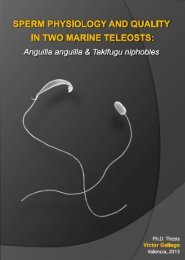8 - RiuNet - UPV
8 - RiuNet - UPV
8 - RiuNet - UPV
Create successful ePaper yourself
Turn your PDF publications into a flip-book with our unique Google optimized e-Paper software.
8 th International Symposium on Fruit Flies of Economic Importance. Valencia 2010.<br />
FEMALE RECEPTIVITY MODULATION IN ANASTREPHA FRATERCULUS: THE<br />
ROLE OF SPERM AND MALE ACCESSORY GLANDS PRODUCTS.<br />
Abraham, Solana *1,2 ; Willink, Eduardo 1 , Cladera, Jorge L. 3 & Vera, M. Teresa 1,2<br />
1 Sección Zoología, EEAOC, Tucumán, Argentina; Email: solanaabraham@yahoo.com.ar; 2 CONICET, Argentina;<br />
3 Instituto de Genética, INTA Castelar, Buenos Aires, Argentina.<br />
Background: Renewal of receptivity in females may reduce reproductive success of the first<br />
male. It is expected that males develop ways to manipulate female receptivity and avoid mixture<br />
of rival’s sperm. In several fruit flies, at least two mechanisms were examined: sperm effect and<br />
male accessory glands products (AGPs) effect. Here we evaluated the role of sperm and AGPs<br />
in the renewal of A. fraterculus female receptivity and how this was affected by the diet the<br />
male was provided and male origin.<br />
Methods: First, females were mated with males fed either sugar, low quality protein (3:1 sugar:<br />
protein ratio), high quality protein (same ratio) and the standard adult diet (sugar, protein,<br />
vitamins and corn hydrolyze). Wild and laboratory flies were evaluated. After the first<br />
copulation, different sets of females were used to determine female remating rate, refractory<br />
period, and sperm stored. Second, we evaluated the receptivity of females microinjected with<br />
AGPs in two set of trials. In the first, laboratory females were injected with AGPs of laboratory<br />
males fed either with sugar or the standard diet. In the second, laboratory and wild females were<br />
injected with AGPs of laboratory and wild males, all of them fed with standard diet. Female<br />
receptivity was evaluated 48 h after injection and the control were females injected only with<br />
saline. Differences in the frequency of remating females among treatments were compared with<br />
� 2 -tests with Bonferroni’s correction. Refractory period and amount of sperm stored were<br />
analysed with ANOVA coupled with Tuckey’s test.<br />
Results: Wild females mated with sugar males presented a higher remating rate and a shorter<br />
refractory period than those mated with standard diet males. Amount of sperm stored in females<br />
mated with sugar or low quality protein males was significantly lower than that stored in<br />
females that mated with standard diet males. Laboratory females also showed a lower refractory<br />
period when mated with sugar males compared to females mated with protein males irrespective<br />
of the protein quality. However, remating rate and amount of sperm stored was not affected by<br />
the diet. Additionally, females injected with AGPs of laboratory standard diet males had lower<br />
receptivity than females injected with AGPs of laboratory sugar males, which in turn were equal<br />
to control females. Females injected with AGPs from laboratory males had lower receptivity<br />
than females injected with AGPs from wild males (which were equal to the control),<br />
irrespective of female origin.<br />
Conclusions: Male nutritional status and origin affects female renewal of the receptivity. In wild<br />
flies this seems to be related with the sperm stored in the female. However in laboratory flies,<br />
the sperm effect seems to be not the only responsible of modulating these changes. Male<br />
nutritional status and origin also affected female receptivity trough an AGPs effect. The later<br />
may be related to the crowded conditions under laboratory rearing where laboratory males may<br />
need to increase the effectiveness of their AGPs to ensure its paternity.<br />
Keywords: polyandry, remating inhibition, sperm effect, accessory gland effect, South American fruit fly.

















